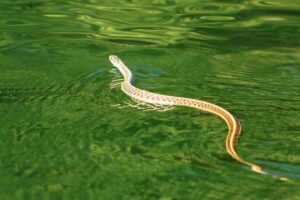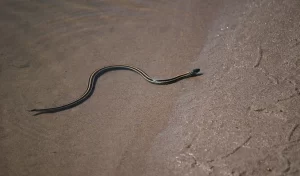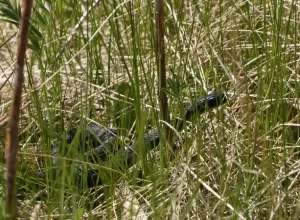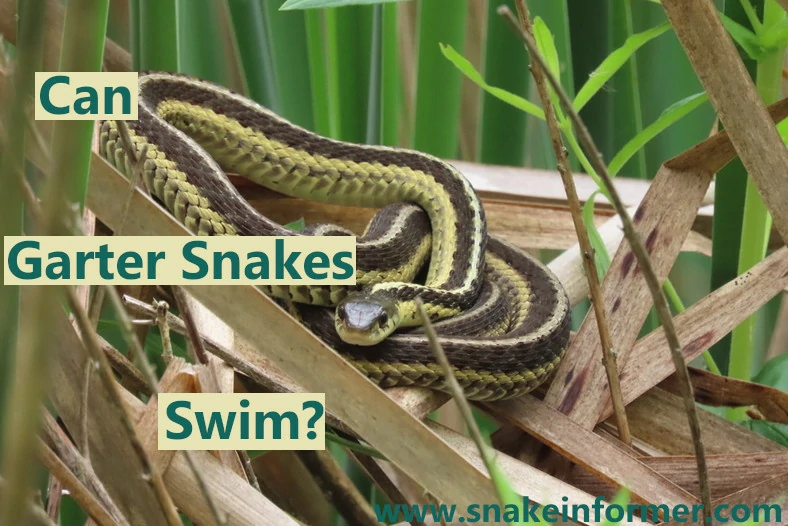Garter snakes are medium sized snakes found in North and Central America. Due to their wide distribution, these snakes are often near water bodies.
Like all snakes, garter snakes can swim. They swim by wriggling their bodies from side to side, in a winding motion, while keeping their heads above the water.
Many garter snake species, particularly those that live close to water bodies, are semi-aquatic.
These snakes often spend a significant amount of their time in the water they dive hunt for small fish, slugs, and other aquatic prey.
They can also dive underwater, and stay submerged for as long as 30 minutes, before returning to the surface to breathe (more information on that is bellow).
All Snakes Can Swim
Most snakes are naturally buoyant and can instinctively swim, garter snakes included.
They swim in a similar way to how they move on land; by winding their bodies in an ‘S’ shape, while they keep their heads above the water.

Snakes that are highly adapted for swimming can hold their breath and dive underwater, staying submerged for a few minutes before returning to the surface.
That said, some snakes are more comfortable in the water and are stronger swimmers than others.
Why Do Garter Snakes Swim?
Garter snakes have a very wide distribution, and can be found in a variety of environments, from wetlands to forests, to mountainous areas, to dry regions.
For this reason, these snakes have adapted to effectively move through a wide variety of habitats.
Garter snakes can swim, move across sand, and even climb trees, with relative ease.
Here are a few things that garter snakes use their swimming ability for:
1. Hunting
Like all snakes, garter snakes are obligate carnivores. Their ability to swim is very important as they hunt for prey, near water bodies.
These snakes can catch snails, leeches, earthworms, frogs, toads, salamanders, toads, newts, and even small fish in the water.

Garter snakes are not picky eaters, and will catch almost any prey they can catch and swallow whole (snakes do not chew their food).
They use their sense of smell, as well as their vision to detect and hunt for prey.
Some garter such as the aquatic garter snake (Thamnophis atratus) flick their tongues above the water, to mimic an insect and lure fish.
2. General Locomotion
Swimming is an efficient way for garter snakes to move around, in an environment with lots of water bodies.
They will regularly swim across small ponds to get to areas with better food better food, hiding spots, or other resources needed for their survival.
Often, garter snakes will swim simply to move across different areas of their habitat.
3. Predator Avoidance
Garter snakes are eaten by a wide variety of predators, such as crows, hawks, foxes, raccoons, and even larger snakes.
For this reason, these snakes developed several ways to defend themselves.
As a first line of defense, most garter snakes will remain motionless, and rely on their camouflage to blend into their environment. Their coloration makes them hard to see in grassy areas.

However, when they are spotted by a predator, these snakes will attempt to escape.
Their ability to swim means they can flee into the water to quickly escape predators on land.
Some Garter Snake Species Swim Better Than Others
Although all garter snake species can swim, some garter snake species are better swimmers than others.
In general, garter snake species that live closest to marshes, ponds, streams, and lakes tend to be better swimmers than species that typically occur further inland.
Can Garter Snakes Breathe Underwater?
Like all reptiles, garter snakes have lungs, that they use to breathe air.
Despite their various adaptations to semi-aquatic life, garter snakes can not breathe underwater.
Most garter snakes only hunt at the water’s edge, or in shallow water, and do not stay submerged for long.
How Long Can Garter Snakes Stay Underwater?
How long a garter snake can stay underwater after is mainly dependent on 3 factors, namely: the species, how active the snake is, and the temperature.
Depending on these factors, garter snakes can stay underwater anywhere from 1 minute, to over half an hour.
1. Species
Some garter snake species are more aquatic and are better at holding their breath than others.
For example, aquatic garter snakes (Thamnophis atratus), are very highly aquatic and can hold their breath for up to 30 minutes as they dive underwater.
On the other hand, western terrestrial garter snakes (Thamnophis elegans) are primarily terrestrial and can only be underwater for less than 10 minutes.
2. How Active the Snake Is
Activity affects how much oxygen the body needs.
Think about it. When you are running or jogging, you breathe in much quicker breaths than when you are lying on the couch.
For snakes, this is also true. Their oxygen demands will be influenced by their activity levels.
A garter snake that is resting on the bottom of the water may be able to stay submerged for a significant amount of time.
On the other hand, an individual of the same species who is escaping a predator or chasing prey – may only be able to stay underwater for a few minutes before needing to surface to replenish its oxygen supply.
3. Temperature
Like all reptiles, garter snakes are cold-blooded (ectothermic) animals.
This means they cannot internally regulate their body temperature. Instead, their body temperature changes with the temperature in their surroundings.
In other, their environment is the main influence on their body temperature.
For example, a garter snake swimming in 30°C (86°F) water has a body temperature very close to 30°C. In water at 15°C (59°F), the body temperature is around 15°C.
Being ectothermic means garter snakes will have a varied rate of metabolism, depending on the water temperature.
Warmer water temperatures increase metabolic rates. This means garter snakes have to resurface more often to get oxygen.
On the opposite end, cooler water allows garter snakes to conserve oxygen. This extends the time they can hold their breath.
Conclusion
Garter snakes live in a wide variety of habitats from grasslands to woodlands, often near wetlands, ponds, or streams.
These snakes frequently venture into the water and are excellent swimmers.
Garter snakes find a large portion of their prey in or near water. They hunt frogs, toads, newts, snails, leeches, earthworms, and even small fish.
In general, amphibians tend to make up a significant part of most garter snakes diets.
Apart from hunting, these snakes also rely on their swimming ability to move between different parts of their habitat – and also to escape land predators.
Sources:
Guillaume Fosseries, Anthony Herrel, et al. Can all snakes swim? A review of the evidence and testing species across phylogeny and morphological diversity, Zoology, Volume 167, 2024, 126223, ISSN 0944-2006, https://doi.org/10.1016/j.zool.2024.126223.
Hi, my name is Ezra Mushala, i have been interested animals all my life. I am the main author and editor here at snakeinformer.com.

